Bon Block Prints & Yantra - Added
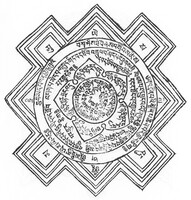
A gallery of block print images and yantras of the Bon religion has been added. They look almost indistinguishable from the Buddhist yantra. The differences are found in the inscriptions.


A gallery of block print images and yantras of the Bon religion has been added. They look almost indistinguishable from the Buddhist yantra. The differences are found in the inscriptions.
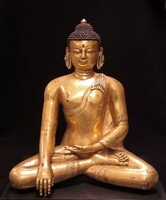
A gallery containing Sculpture Annotations has been added to the site. The gallery conveniently displays most of the annotated versions of sculpture and three dimensional objects that have been created for the HAR site but previously had not been collected together into a central location.
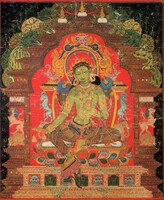
A gallery containing Painting Annotations has been added to the site. The gallery conveniently displays most of the annotated versions of paintings and flat art that have been created for the HAR site but previously had not been collected together into a central location.

Secret codes, symbols, cyphers and alphabets have probably been used by all cultures since the beginning of the written language. Tantric Buddhist have many secret and sacred alphabets and scripts. With this example, each letter on its own is considered powerful and efficacious. The letters combined together are considered even more powerful.
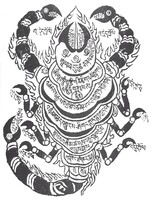
Yantra of various types are found throughout Tantric literature and the supplementary practices. The Scorpion Yantra is generally associated with the practices of Guru Dragpo, a wrathful form of Padmasambhava, who holds the creature in the outstretched left hand. Each of the examples in this gallery have mantra inscriptions identifying the yantra with Guru Dragpo. A number of other fierce Nyingma deities have the scorpion as a servant or messenger figure. A very good example is Black Hayagriva.
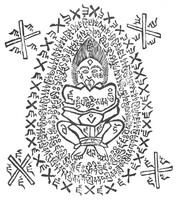
Drawings or blockprints of Tantric Effigies known as 'linga' are part of the Vajrayana Buddhist arsenal of weapons against obstacles, enemies, demons and spirits. There is an almost endless variety of configurations and creative designs. The drawings, originating in an Indian cultural context, generally belong under the broader classification of Yantra.

A new glossary listing Buddhist Titles and Honorifics has been added to the Main Glossary Page. It also is a work in progress. For specific retreat terminology see the Meditation & Retreat Terms Glossary.

A new glossary listing the special Monastic Titles and Terms has been added to the Main Glossary Page. It is a work in progress and longer definitions and links where possible still need to be added for each entry.
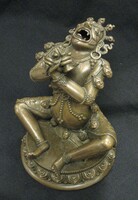
Each deity figure in this gallery has a written inscription on the front or back of the base.
Inscription Subjects:
- Name of the Figure
- Four Line Praise
- Mantra
- Dedication (Mother, Father, Teacher, etc.)
- Name of the Donor
- Name of the Artist
- Other....
(The images in the gallery are only a small selection of sculpture with inscriptions).
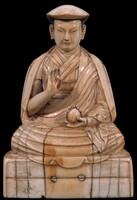
Each of the sculpture pieces in this gallery has a written inscription on the front or back of the base. Sometimes the inscriptions are lengthy and can circle the entire base even creating several lines of text.
Inscription Subjects:
- Name of the Figure
- Four Line Praise
- Mantra
- Dedication (Mother, Father, Teacher, etc.)
- Name of the Donor
- Name of the Artist
- Other....
(The images in the gallery are only a small selection of sculpture with inscriptions).
Indian, Nepalese and Tibetan Illuminated Manuscript Pages have been added to the LACMA Main Page.
The Painting Gallery on the HAR website for the Los Angeles County Museum (LACMA) has been expanded and updated. See the LACMA Main Page.
The Sculpture Gallery on the HAR website for the Los Angeles County Museum of Art has been updated and expanded. See the LACMA Main Page on HAR.

There are a number of miscellaneous elements other than the standard [1] inscriptions, [2] stupas, [3] hand prints and [4] mandalas, that can be found on the backs of paintings. The miscellaneous elements can include thumb prints, seals, sketches, drawings and large mantra monograms such as for the deity Kalachakra.

There are several categories of inscriptions that can appear on the back of a painting. In order of occurrence there are three standard elements and two elements relating to the subject of the painting and the wishes of the donor:
1. Three Syllables: OM, AH, HUM (standard),
2. Auspicious Mantras (standard),
3. Auspicious Verses (standard)
4. Miscellaneous Extra Verses (donor added),
5. Dedicatory Verses (donor added)
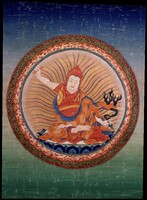
Hand Prints: impressions from life, of famous Buddhist teachers, predominantly Kagyu, Gelug and Nyingma placed on the backs of paintings.
The most common additions to the back of a painting are:
[1] Mantras/dharanis,
[2] Auspicious verses,
[3] Stupa Drawing (or the inscriptions in the shape of a stupa),
and [4] Hand Prints.
(The images in this gallery are only a selection of hand print examples).
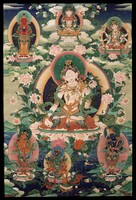
Drawings of Stupas along with inscriptions in the shape of a stupa placed on the backs of paintings are a common form of blessing and sanctification. The most common additions to the back of a painting are: [1] mantras/dharanis, [2] auspicious verses, [3] stupa drawing (or the inscriptions in the shape of a stupa), and [4] hand Prints.(The images in this gallery are only a selection of stupa examples).
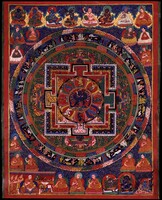
Mandala images either diagrammatic or created from letters are sometimes found on the reverse of paintings. When the front subject of a painting is also a mandala then the reverse can have letters or words that mirror the shape of the mandala on the front. (The images in this gallery are only a selection of mandala examples).

In the painting collection of the Royal Ontario Museum there is a black ground composition depicting Shadbhuja Mahakala. It was generally believed that this painting was created as a single composition. Recently another painting by the same artist, also depicting a variant and less well known form of Shadbhuja, was identified. It is very likely that these two compositions were created as a set, or a series of compositions, depicting each of the seven main forms of Shadbhuja Mahakala. The iconographic descriptions for these two works is based on the writings of Kedrub Geleg Pal Zangpo, one of the foremost students of Lama Tsongkapa. Tsongkapa is depicted at the top left of both works and Kedrub is depicted at the top right.
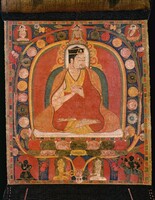
The paintings in this gallery depict the first three Karmapas. The works were all created in the 13th and 14th centuries and depict the Karmapas wearing a black hat. Granted, the hat is not as ornate as the black hat created by the Yongle Emperor of China and given to the 5th Karmapa Deshin Shegpa (1384-1415). Regardless of that, the paintings clearly show that the Karmapas had a tradition of wearing a black hat prior to the gift of the Chinese Emperor.